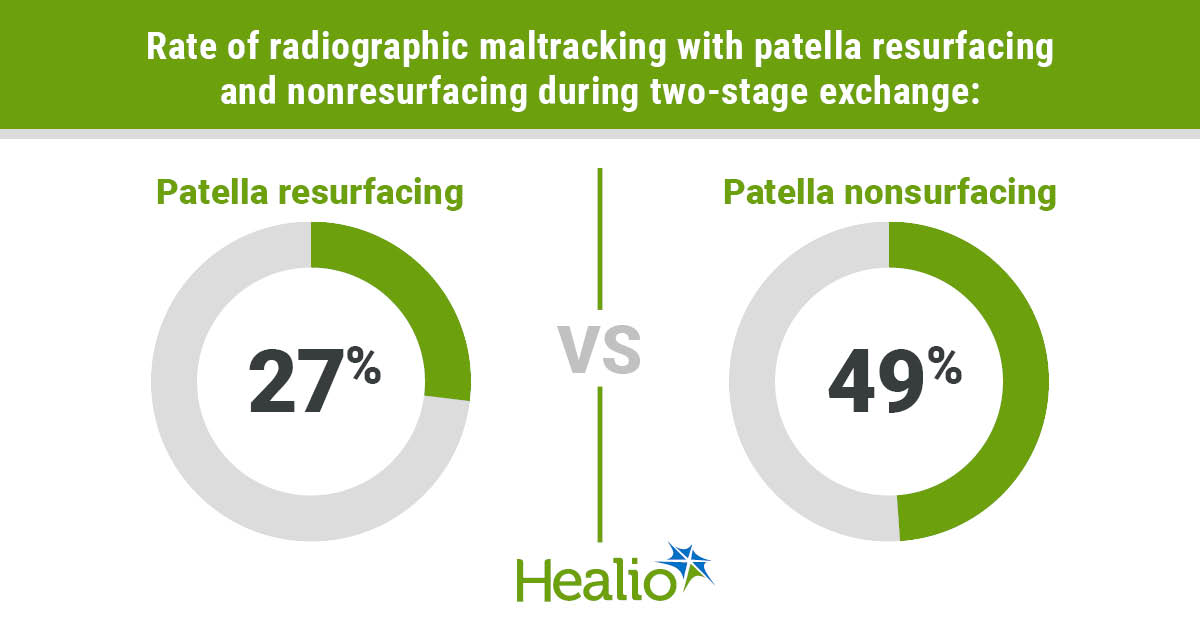August 21, 2025
2 min read
Key takeaways:
- Patients with resurfaced and nonresurfaced patellas had similar patient-reported outcome scores at 1 year.
- However, the nonresurfaced group had a higher rate of maltracking vs. the resurfaced group.
JERSEY CITY, N.J. — Results presented here showed resurfacing the patella during a two-stage exchange reduced the incidence of maltracking and had comparable implant survivorship with nonresurfaced patellas.
“At the end of the day, if the kneecap is too thin and you are worried about complications, leave it alone. Clinically, it does not seem to adversely affect patient outcomes more than if you took the risk and resurfaced it,” Alberto Carli, MD, a hip and knee replacement surgeon at Hospital for Special Surgery, told Healio about results presented at the Musculoskeletal Infection Society Annual Meeting. “But if the bone is good and you feel comfortable about being able to put a new button in, you should expect that that patient will have better tracking of the patella and, hopefully, better quadriceps function.”

Data were derived from Jolissaint JE, et al. Paper 1538. Presented at: Musculoskeletal Infection Society Annual Meeting; Aug. 1-2, 2025; Jersey City, N.J.
Carli along with Josef Jolissant, MD, Andrew Thomson, a clinical researcher at Hospital for Special Surgery, and colleagues retrospectively reviewed data from 106 patients who underwent two-stage exchange between 2017 and 2022 for treatment of periprosthetic joint infection after total knee arthroplasty.
In his presentation, Thomson said patients were categorized based on whether they underwent resurfacing with a new patella component or not.

Andrew Thomson
“We collected demographic data, comorbidities and preoperative lab markers, as well as intraoperative culture results and data on postoperative complications,” Thomson said. “Functional outcomes were assessed at 1 year using [patient-reported outcome measures] such as KOOS, VAS pain scores as well as range of motion measured at follow-up visits.”
At 1-year follow-up, Thomson said the resurfaced and nonresurfaced groups had no significant differences in KOOS scores, VAS pain scores or range of motion. However, he said 49% of patients in the nonresurfaced group had radiographic signs of maltracking vs. 27% in the resurfaced group.
“Observed complications at 1 year saw an overall complication rate that was significantly lower in the resurfaced group,” Thomson said. “However, when infection-related reoperations were excluded, it was no longer statistically significant. Extensor mechanism complications and reoperations for infection had similar rates irrespective of whether the patella was resurfaced or not.”
According to Thomson, the reoperation-free survival at 2 years was similar between the groups, but there was a trend toward higher survival probability among patients with resurfaced patellas.

Alberto Carli
Despite these results, Carli said more research needs to be done with larger numbers of patients, multiple centers and imaging. He also said more involved questioning of surgeons who treat infections after TKA is needed to understand the decisions they make.
“That answer is not necessarily restricted to the infection world. We can also get that information from the noninfected patients,” Carli told Healio. “The only difference is the noninfected patients usually go through one operation, while here we are looking at patients who go through two or more operations when they have an infection.”
For more information:
Alberto Carli, MD, wishes to be contacted through Robin Frank at frankr@hss.edu.









